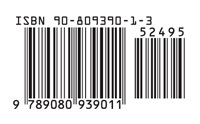 How to sell
How to sell
modular arithmetic to students only interested in literature? Well, try
to explain the structure of ISBN-numbers
“The ISBN (International Standard Book Number) is a unique
machine-readable identification number, which marks any book
unmistakably. This number is defined in ISO Standard 2108. The number
has been in use now for 30 years and has revolutionised the
international book-trade. 166 countries and territories are officially
ISBN members. The ISBN accompanies a publication from its production
onwards.” The ISBN-number of a book is a ten-digit number divided into
four parts, separated by hyphens telling you a lot about the ambitions
and location of the book’ publisher. I’ll explain some of it by
telling how I obtained the barcode for the first book to be published by
neverendingbooks.org (see
picture). The first part is the group
identifier and identifies a country, area or language area
participating in the ISBN system. For the Netherlands and the Flemish
speaking part of Belgium this identifier is 90. Hence,
depending on your location you have to approach different agencies in
order to obtain an ISBN-number. If you are living in the US all you have
to do is to invent a name for your PublishingHouse, get your Visa-card
out and visit isbn.org
. For smaller groups the process is more personal. The first time I
tried to apply for an ISBN-number with De Boekenbank I
messed up and got immediately an email telling me what I did wrong. I
replied explaining what NeverEndingBooks had in mind and asked advice on
how to set it up properly. I’m sure I’ll need this personal contact
again in the near future. The second part is the _Publisher
Identifier_ or _prefix_. I didn’t know this before but the
very definition of a _publisher_ is the person or company
registering a book’s ISBN. Hence, if you intend to publish a series of
books your local ISBN-agency has to reserve a certain amount of
ISBN-numbers for you, all having the same start-block (the prefix). The
shorter the prefix the more ambitious the PublishingHouse. The
registered prefix of NeverEndingBooks is 90809390 which
tells the experienced ISBN-watcher that we intend in the next years to
publish “only” ten books. If you have more energy you can also apply
for a series of 100, 1000 or even 10000 ISBN-numbers but the amount of
money needed to register these series increases quickly… The third
part of the ISBN-number is the _title identifier_ so for our
first book it is just 1. However, in order to register
it you have to provide the agency (minimally) with a title and
publication date (fortunately, author, price, number of pages etc. are
optional at this stage). Anyway, the first real deadline for
NeverEndingBooks will be may 15th 2005! And now it is time to return
to modular arithmetic, the fourth part is a _check digit_. The
check digit is the last digit of an ISBN. It is calculated on a modulus
11 with weights 10-2, using X in lieu of 10 where ten would occur as a
check digit. This means that each of the first nine digits of the ISBN
excluding the check digit itself is multiplied by a number
ranging from 10 to 2 and that the resulting sum of the products, plus
the check digit, must be divisible by 11 without a remainder. In our
case, we have the following numbers(weights) 9(10) 0(9) 8(8)
0(7) 9(6) 3(5) 9(4) 0(3) 1(2) We have to multiply the numbers
with their weight and add them all up,
90+0+64+0+54+15+36+0+2=261=8(mod 11) whence the check
digit should be 3. For example, I know already that the
ISBN-number of the second book to be published by NeverEndingBooks will
be 90-809390-2-1 but, due to lacking information, it will take a while
before it can be registered.
ISBN prefix
Published in featured
One Comment